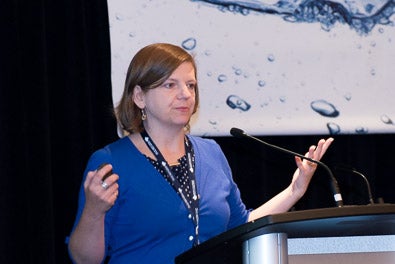Progress
on
new
artificial
intelligence
(AI)
technology
could
make
monitoring
at
water
treatment
plants
cheaper
and
easier
and
help
safeguard
public
health.
Researchers
at
the
University
of
Waterloo
have
developed
AI
software
capable
of
identifying
and
quantifying
different
kinds
of
cyanobacteria,
or
blue-green
algae,
a
threat
to
shut
down
water
systems
when
it
suddenly
proliferates.
“We need to protect our water supplies,” said Monica Emelko, Water Institute member and professor in Waterloo's Department of Civil and Environmental Engineering. “This tool will arm us with a sentinel system, a more rapid indication when they are threatened.
“The exciting piece is that we’ve shown testing utilizing AI can be done quickly and well. Now it’s time to work through all the possible scenarios and optimize the technology.”
The
operational
AI
system
uses
software
in
combination
with
a
microscope
to
inexpensively
and
automatically
analyze
water
samples
for
algae
cells
in
about
one
to
two
hours,
including
confirmation
of
results
by
a
human
analyst.
Current
testing
methods,
which
typically
involve
sending
samples
to
labs
for
manual
analysis
by
technicians,
take
one
to
two
days.
Some
automated
systems
already
exist
as
well,
but
they
require
extremely
expensive
equipment
and
supplies.

Moving forward, the goal is an AI system to continuously monitor water flowing through a microscope for a wide range of contaminants and microorganisms.
“This brings our research into a high-impact area,” said Wong. “Helping to ensure safe water through widespread deployment of this technology would be one of the great ways to really make AI count.”
The researchers estimate it may take two to three years to refine a fully commercial sample testing system for use in labs or in-house at treatment plants. The technology to provide continuous monitoring could be three to four years away.
“It’s critical to have running water, even if we have to boil it, for basic hygiene,” said Monica Emelko, a professor of civil and environmental engineering at Waterloo. “If you don’t have running water, people start to get sick.”
Adjunct
engineering
professor
Chao
Jin,
doctoral
student
and
winner
of
the
2017
AquaHacking
Competition
Jason
Deglint,
and
research
associate
Maria
Mesquita
are
also
collaborators.
A
study
on
the
research,
Quantification
of
cyanobacterial
cells
via
a
novel
imaging-driven
technique
with
an
integrated
fluorescence
signature,
was
recently
published
in
the
journal
Scientific
Reports.